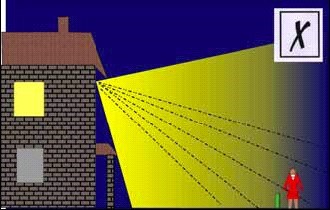Home Security Lighting
How to avoid annoyance to neighbours
Well designed and installed security lights can bring comfort to our lives, providing a sense of security in our homes. However, unsuitable or improperly installed lighting can cause annoyance to neighbours, especially from glare. Some simple guidelines to follow when installing new security lights are given below.
Keep the Level of Illumination to a Minimum
Domestic security lights should provide the minimum level of illumination necessary to light a property. A 150W (1000 lumen) lamp is normally adequate. For an all-night porch light, a 9W lamp is more than adequate in most situations. The use of a high powered lamp not only wastes energy and money, but also causes more glare and makes shadows appear darker than otherwise, potentially compromising security.
Prevent Movement Sensors Triggering Unnecessarily
Security light sensors should be adjusted so that they only pick up the movement of people in the area intended on your property and not beyond, for example on nearby premises or on adjoining public footpaths. Whilst many security lights are fitted with integral movement sensors, it is possible to use a separate detector that can be aimed differently from the light beam; this means that the sensor can be aimed in a way to make it less sensitive to triggering.
Prevent Unnecessary Light Spillage
Ensure that lights are correctly adjusted so that they only light up areas intended and do not throw light onto neighbouring properties. In particular, it is important to reduce the effects of glare by directing light downwards, with the main beam angle of light less than 70 degrees. In the diagrams below, this is the angle between the wall to which the light is attached and the outer edge of the light beam. The height of the light fitting will of course also affect the extent of the lit up area and therefore such lights should not be mounted too high.
What is a Good Installation?
To ensure your installation meets requirements you need to make sure that:
- the angle of the beam is at or below 70 degrees
- the light is not mounted too high so the lit up area is restricted
- the movement detector is not directed over too wide an area.
An example of a good installation is on this page.
How Do I Report a Problem?
Where problems cannot be resolved informally between neighbours, our Environmental Protection Team can investigate and, if appropriate, take action under the Environmental Protection Act 1990 to stop an ongoing nuisance associated with artificial lighting.
For advice and further information please contact us.

